Wheel Bug
Scientific Name: Arilus cristatus
Order & Family: Hemiptera, Reduviidae
Size: 1.5 to 3.8 cm (0.6 to 1.5 inches)

Natural Habitat
Gardens, orchards, agricultural fields, wooded areas; often found on trees, shrubs, and other vegetation.
Diet & Feeding
Predatory; feeds on a variety of insects, including caterpillars, Japanese beetles, assassin bugs, sawflies, and other soft-bodied insects. It uses its rostrum (piercing mouthpart) to inject salivary fluids that paralyze and dissolve the prey's tissues, then sucks out the liquefied contents.
Behavior Patterns
Nocturnal and solitary. It is an ambush predator, often remaining still on vegetation, waiting for prey. When disturbed, it can emit a sound by rubbing its rostrum against a groove on its prosternum. It is known for its slow movement. The distinctive cogwheel-like structure on its pronotum is a key identifying feature.
Risks & Benefits
Benefits: Considered beneficial in gardens and agriculture as a natural predator of many pest insects. Risks: Can deliver a very painful bite if handled, which can be comparable to a bee sting. The bite site may swell, become red, and remain painful for several days, sometimes even leaving a small scar. It is not venomous to humans in a life-threatening way, but the bite is purely defensive.
Identified on: 9/21/2025